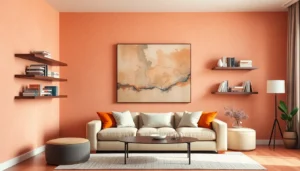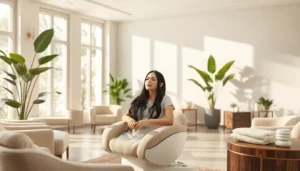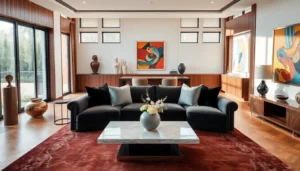In a world overflowing with straight lines and sharp angles, organic design offers a refreshing breath of fresh air. Imagine spaces that flow like a gentle river and colors that mimic nature’s palette. It’s not just about aesthetics; it’s about creating environments that resonate with the soul. Whether you’re revamping your home or sprucing up your workspace, organic design ideas can transform the mundane into the extraordinary.
Think of it as inviting Mother Nature to your next interior design meeting. She’s got great taste and a knack for making any space feel alive. From curvy furniture to earthy tones, the possibilities are endless. So grab your favorite herbal tea and get ready to explore how organic design can add a touch of whimsy and warmth to your life. After all, who wouldn’t want their home to feel like a cozy forest retreat?
Table of Contents
ToggleOverview of Organic Design Ideas
Organic design embodies aesthetic principles that mirror nature. It emphasizes fluidity, soft lines, and natural materials to create inviting environments. Curved furniture adds comfort and movement. Incorporating earthy colors like greens and browns enhances the connection to the outdoor world. Natural light often plays a vital role, brightening spaces and fostering an uplifting atmosphere.
Textures contribute to the organic feel. Wood, stone, and plant elements enhance sensory experiences. Plants, whether small succulents or large leafy trees, purify the air while adding vibrancy to interiors. Furnishings made from sustainable materials promote eco-friendliness, aligning with the ethos of organic design.
Patterns inspired by nature often feature prominently in textiles and wallpapers. Floral designs, leaf motifs, or organic shapes on fabrics enrich the overall aesthetic. The use of nature-inspired art can also complete the look, providing focal points that draw attention while remaining soothing to the eye.
Open layouts further support organic design principles. Spaces flow seamlessly, fostering interaction and movement. Areas that encourage communal activities create a sense of togetherness, reflecting natural social behaviors.
Customization is another key aspect. Individuals can adapt organic design ideas to fit their personal tastes and lifestyle. Custom solutions allow for creativity and self-expression, ensuring that each space feels unique and alive.
Incorporating these organic elements transforms ordinary environments into extraordinary ones. Embracing these ideas leads to homes and workspaces that resonate emotionally, creating a balance between functionality and beauty.
Principles of Organic Design
Organic design principles prioritize nature, fostering spaces that connect individuals to their environment. These principles integrate natural elements, enhancing comfort and emotional well-being.
Emphasis on Nature
Nature plays a crucial role in organic design. Natural materials like wood and stone promote warmth and authenticity. Incorporating plants enhances air quality and brings a sense of life indoors. Shades of green, brown, and other earthy tones strengthen the connection to the outdoors. Light-filled spaces, infused with natural light, create an uplifting atmosphere, inviting tranquility. Each of these elements nurtures a feeling of harmony, making the environment more inviting.
Fluidity and Form
Fluidity and form define the essence of organic design. Curved furniture invites movement and connects seamlessly with surrounding spaces. Soft lines evoke comfort, encouraging relaxation and ease in daily activities. Organic shapes mimic those found in nature, avoiding harsh geometric lines. Textiles featuring nature-inspired patterns add depth and visual interest, creating a soothing backdrop. Open layouts foster interaction, enhancing social experiences within the environment. With these principles, organic design cultivates a dynamic, inviting space.
Applications of Organic Design Ideas
Organic design manifests in various applications, significantly influencing architecture and interior design. These implementations foster environments that connect individuals to nature.
Architecture
Architecture embraces organic design through structures that blend seamlessly into their natural settings. Designers use natural materials like wood, stone, and glass to create sustainable buildings. Curved forms often replace traditional straight lines, allowing structures to mimic natural shapes found in the environment. Natural light plays a crucial role in these designs. Thoughtful placement of windows enhances energy efficiency while brightening interiors. Additionally, green roofs and living walls contribute to biodiversity and improve air quality. Architects focus on creating harmonious relationships between buildings and their surroundings, achieving a balance that respects nature.
Interior Design
Interior design incorporates organic elements to craft inviting and nurturing spaces. Curvy furniture options, such as rounded sofas and organic-shaped tables, promote comfort and encourage relaxation. Earthy color palettes featuring greens, browns, and muted tones invite a sense of tranquility. Textures from natural materials like wood and stone enrich surfaces, creating warmth. Integrating plants throughout the space enhances air quality and brings life indoors. Open layouts that facilitate movement and conversation reflect natural flow, making spaces feel more organic and welcoming. Through these thoughtfully chosen elements, interior design fosters environments that resonate with nature and engage the senses.
Benefits of Organic Design Ideas
Organic design ideas offer numerous advantages that enhance living and working environments. Emphasizing a connection to nature, these concepts contribute positively to both aesthetics and well-being.
Sustainability
Sustainable practices define organic design. Utilizing natural materials reduces environmental impact and promotes a greener lifestyle. Recycled elements and locally sourced resources minimize carbon footprints. Landscaping that incorporates native plants fosters biodiversity while requiring less water and maintenance. Energy-efficient designs optimize natural light, decreasing reliance on artificial lighting. Buildings using materials such as wood and stone not only blend with their surroundings but also ensure longevity. Through these efforts, organic design aligns closely with sustainability goals, creating spaces that nurture both occupants and the environment.
Aesthetic Appeal
Aesthetic appeal flourishes with organic design elements. Curved furniture creates a sense of flow and comfort. Soft lines evoke relaxation, making spaces inviting and warm. Earthy color palettes, including greens and browns, establish a tranquil atmosphere reminiscent of the outdoors. Natural light enhances interior spaces, bringing life and vibrancy. Textural contrasts from wood and stone enrich surfaces, adding depth and interest. Integrating plants introduces natural beauty and enhances air quality, making environments feel more alive. All these aspects culminate in a design approach that resonates with emotions and brings the essence of nature indoors.
Challenges in Implementing Organic Design Ideas
Implementing organic design ideas presents unique challenges that designers and homeowners frequently face. Adapting to the principles of organic design often requires a significant shift in mindset regarding traditional aesthetics. Sourcing sustainable materials can prove difficult, as not all regions offer easy access to options like reclaimed wood or eco-friendly finishes.
Balancing aesthetics and functionality also poses a challenge when integrating organic elements. Spaces must remain practical, promoting usability while still embracing curvy forms and fluid designs. Additionally, achieving a harmonious atmosphere calls for careful consideration of color palettes. Designers often grapple with finding the right shades that evoke a natural feel without clashing with existing elements.
Budget constraints frequently hinder the realization of organic design visions. High-quality natural materials tend to come at a premium, making it essential to prioritize investments in key areas while compromising elsewhere. Time also plays a role, as incorporating organic elements can require extended timelines for selection, design, and construction.
Finding skilled artisans or professionals familiar with organic techniques might limit options. Many traditional contractors may not understand the intricacies of organic design, resulting in misalignment with intended outcomes. Furthermore, educating clients on the benefits and nuances of organic design can prove challenging, especially when they’re accustomed to conventional styles.
Despite these challenges, perseverance and creativity often lead to stunning transformations. Approaching design with flexibility and openness typically results in solutions that beautifully merge nature and function, enriching spaces while promoting well-being.
Embracing organic design ideas can truly transform spaces into havens of comfort and connection to nature. By incorporating natural materials and fluid forms, individuals can create environments that are not only aesthetically pleasing but also promote well-being. The focus on sustainability and the thoughtful integration of plants and textures enriches both the visual and sensory experience.
While challenges may arise in sourcing materials and balancing functionality with beauty, the rewards of organic design far outweigh the obstacles. Through creativity and dedication, anyone can craft spaces that resonate with nature, fostering a sense of tranquility and harmony. Ultimately, organic design isn’t just a trend; it’s a lifestyle choice that nurtures both people and the planet.






